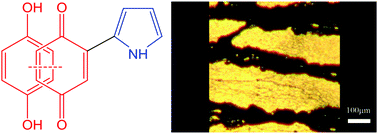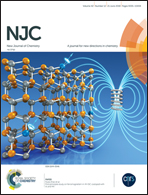Oxidation of pyrrole with p-benzoquinone to semiconducting products and their application in electrorheology
Abstract
A low-molecular-weight organic semiconducting material was prepared by the redox interaction between pyrrole and p-benzoquinone. The reaction between pyrrole and p-benzoquinone in aqueous solutions of methanesulfonic acid proceeded smoothly at room temperature. The product with a globular morphology obtained in high yield in 0.1 M methanesulfonic acid had the highest conductivity, 4.6 × 10−6 S cm−1. On the other hand, the samples prepared in the absence of acid or at high acid concentration were non-conducting. EPR spectroscopy confirmed the presence of electronic species as charge carriers responsible for conductivity. The dominating component was proved to be a low-molecular-weight adduct composed of the quinhydrone complex and the pyrrole molecule. FTIR and Raman spectra were used to discuss the molecular structure in detail. A strong electrorheological effect with a very fast response time was demonstrated by the reproducible increase in the viscosity of suspensions in silicone oil after application of the electric field. The effect is discussed with the help of dielectric spectroscopy.



 Please wait while we load your content...
Please wait while we load your content...